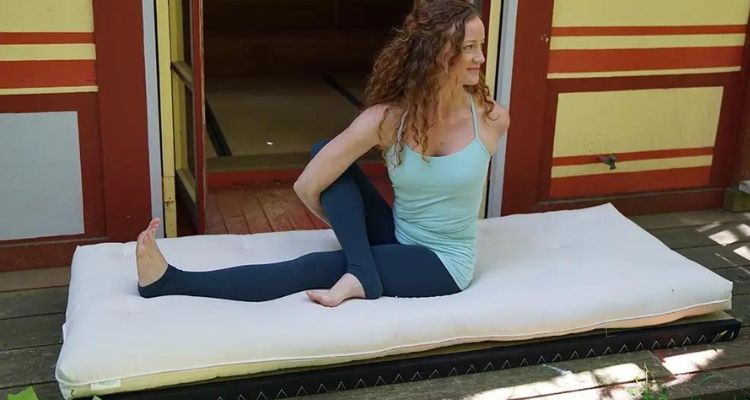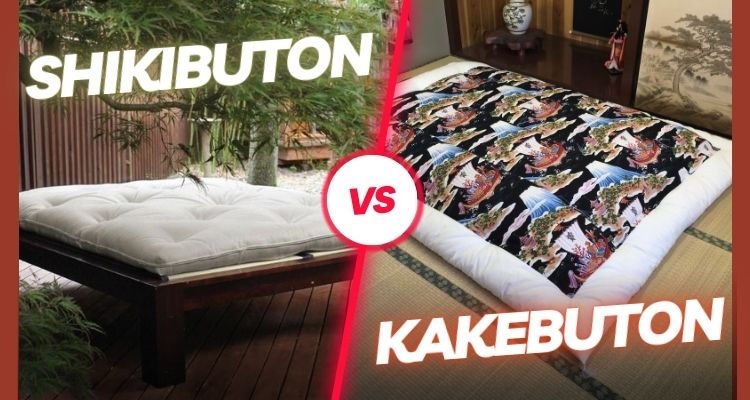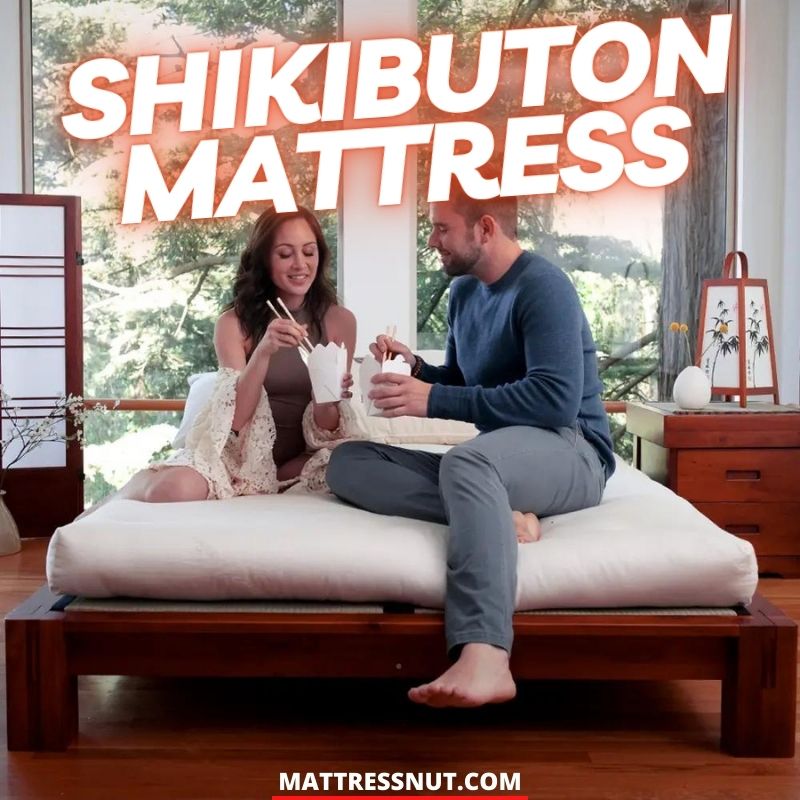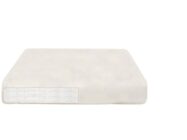Japanese people have lived in cramped spaces for centuries, and they discovered an excellent solution to this problem a long time ago. Some Japanese folks sleep on shikibuton mattresses laid directly on the floor. This mattress does not require a bed frame or a folding futon frame. They are the best investment if you live in a small apartment that a traditional mattress cannot accommodate.
This article will offer you all the information about a shikibuton bed.
Traditional Japanese Futon Shikibuton Mattress Reviewed
This Mattress Will Keep You Comfortable Throughout The Year.
Looking for an excellent shikibuton mattress that can keep you comfy all year? Then you should think about this Mattress by The Futon Shop. The Futon Shop Shiki Futon Mattress, sometimes called a Shikibuton, is a handcrafted futon in traditional Japanese furniture.
This mattress offers an extra-softer sleeping surface for side sleepers, sitting, and those weighing less than 140 pounds. This means it’s softer than a firm mattress and offers mild support at the shoulders, knees, and hips.
The batting or stuffing of this mattress comprises sustainably farmed wool and non-GMO starch PLA fiber. In futon mattresses, PLA fiber, like natural polyester fiber, resists body impressions without petrochemicals. PLA fiber is non-toxic and aids in moisture removal, making the Shiki Futon mattress ideal for hot sleepers.
A breathable organic cotton twill cloth encases everything inside. Because you cannot remove this cover, you must spot-clean this mattress. To make the Organic Cotton Shiki Futon mattress last longer, you should air it out, flip it, and move it around often.
The 100% waterproof organic cotton cover from the futon shop will secure your shikibuton mattress. It will completely protect your mattress from spills and accidents. The organic cotton waterproof cover zips around your shikibuton mattress.
What is a Shikibuton Mattress?
Shikibuton, often spelt shikifuton, is a traditional Japanese cotton mattress. Conventional shikibutons are thin, oblong sleeping cushions far more adaptable than the bulkier futons most people are familiar with. Layers of cotton and other fabrics make up their outer cover, and wool, down, or feathers provide insulation.

This mattress is incredibly lightweight, and you can fold it up and store it, improving your storage space when it is not used as a sleeping surface. When rolled out, it’s usually between 3 and 4.5 inches in thickness, giving the sleeper the sense of sleeping on the ground but with a bit more support.
What is the Difference Between a Futon and a Shikibuton?
A traditional futon is a foldable and flexible bed form that you can use on the floor or a frame. The futon mattress’s thickness can range from three inches to up to nine inches on average.
A shikibuton is a type of futon mattress traditionally used in Japanese homes and placed directly on the ground. The shikibuton has a loft that ranges from 3″ to 4″, and its thickness is approximately half that of a regular Western futon.
Other significant distinctions between the futon and shikibuton mattresses include:
Shikibutons:
- Easily portable.
- Lightweight.
- Thin enough for folding and storage when not in use.
- Traditionally made with wool and cotton.
- It can only be used on the floors.
Futons:
- It’s too thick to fold up.
- Heavyweight
- tends to become a permanent fixture in the home.
- Take up additional space on the floor.
- Typically constructed with a spring mattress and synthetic fibers.
If you live in a tiny, confined space, want the flexibility of simple living, or want to build an open-space vibe within your house, a shikibuton—or two placed on top of one another is the optimal option for the main bed or guest bed.
How Long Does a Shikibuton Last?
Shikibutons can last for three to five years or perhaps many more years if cared for properly and thoughtfully. Since cotton fibers absorb moisture and we lose at least a pint of water from our bodies while sleeping, these unique mattresses necessitate special support to keep them fresh and aerated so they don’t clump or form mildew.
There are a few things you can do to extend the life of your shikibuton. Applying a mattress protector should be your first and essential priority. This will aid in preventing dust and stains from accumulating. Second, regularly fluff the mattress to ensure the filling is evenly distributed. Finally, don’t forget to give your shikibuton at least one worthwhile airing once every month.
What is the Difference Between Shikibuton and Kakebuton?
A kakefuton is a type of traditional Japanese duvet (or kakebuton). It’s frequently filled with silk threads, which help maintain and distribute heat evenly while being hypoallergenic and dust mite-repellent.
These comforters are similar to the duvets often used in western countries because their covers are typically removable. These comforters are frequently crafted from airy, hand-pulled silk that is light in weight. As a consequence of this, they are an excellent alternative to any conventional comforter.

Shikibuton (also shikifuton) is a type of traditional Japanese cotton mattress. The thickness of these mattresses ranges from three to four inches, and they contain layers of cotton and wool padding tucked beneath a cotton covering. In addition, they are lightweight and portable mattresses that can be folded or rolled up after usage.
Do You Put Sheets on a Shikibuton?
Yes, you may undoubtedly use sheets on a shikibuton mattress, just as you would on any other type. Fitted sheets protect and clean the shikibuton mattress. Consequently, if you want your shikibuton to have a more modern appearance or your bed to last longer, you will need to cover it with a fitted sheet.
How Often Do You Have to Air Out a Shikibuton?
The frequency you have to dry your shikibuton will be highly impacted by the type of shikibuton mattress you select. The following table provides information on how frequently you should air dry the shikibuton based on the type of material, how long you should air dry it and where you should air it.
Feather: 1-2 times a month; 1-2 hours per side; in the shadow or, if it has a cover, in the sun
Wool: 3-4 times a month; 1 hour per side; in the shadow or, if it has a cover, in the sunlight.
Cotton: daily is OK, but at least once a week; 2 hours per side; in the sunlight
Synthetic fiber: As frequently as feasible, but at least once every week; 2 hours on either side, in the sunlight or the shade.
Is Shikibuton Better for Your Back?
One of the critical advantages of utilizing a shikifuton is that they are much better for your back. Sleeping on a shikibuton is beneficial for your back for two reasons. For starters, it lines up your spine. If you sleep on a mattress that is too soft, your spine will curve, which can, over time, contribute to persistent back discomfort.
Contrary to this, Shikifutons are typically 2-4 inches thick, and sleeping on thin cushioning on the floor may be relatively comfortable. Second, it works the muscles in your lower back while you sleep, helping to make them stronger with each passing hour. While it may be uncomfortable at first, this is because the body is not accustomed to having to exercise those muscles. Many doctors are starting to recommend shikifutons instead of standard mattresses, especially for those with chronic conditions like scoliosis.
How Do You Keep Shikibuton Fluffy?
There is a propensity for shikibutons to create dips where the body rests. If you sleep in the same position every night, rotate the shikibuton once every few days to maintain it fluffy.
You may also “fluff” the shikibuton by holding it up and pounding it with a tennis racket. This will cause the fibers to become more evenly distributed. After hitting your mattress, allow it to breathe fresh air and sunlight for around 30 minutes. This will assist in revitalizing the bed and inflating the futon filling at the same time.
If you do this regularly, your futon will be easier to clean, have a longer lifespan, and droop less. In addition, throughout the day, fold the shikifuton in thirds to extend the fibers that compress when lying on them.
Conclusion
The sort of bed you select is significant since you spend one-third of your time sleeping.
A shikibuton may be an excellent solution for people searching for a space-saving bed or a natural approach to maintaining the spine’s integrity. They’re inexpensive, adaptable, and can cushion your back and a standard bed. The shikifuton mattress is well-made and offers durability, something many customers will enjoy. It has a sleek and opulent appearance that would complement any interior design.
Before buying the shikibuton, consult a physician, chiropractor, or orthopedist to determine whether or not a shikibuton is appropriate for you.
Shikibuton mattress FAQs
Do You Need a Cover for Shikibuton?
Yes, although shikibuon materials are frequently far more pleasant against your body than Western mattress textiles, it is strongly recommended that you use a cover to protect your investment.
How Long Should I Sun My Shikibuton?
The ideal way to care for a futon is to leave it exposed to direct sunshine for around two hours on each side when the sun is at its highest.
How Often Do You Need to Clean a Futon?
Every two to three months, remove the cover or bedding from the futon mattress and let it air out with the help of fans. At this point, you may sanitize your bed by putting baking soda on it, letting it lie for an hour, and then cleaning it.
How Do I Make My Japanese Futon Comfortable?
If your Japanese futon mattress appears too firm when sleeping on top of it, try placing comforters such as covers, duvet covers, quilts, and other comforters around the house to give your bed a softer and plusher feeling when you lie down on it.


